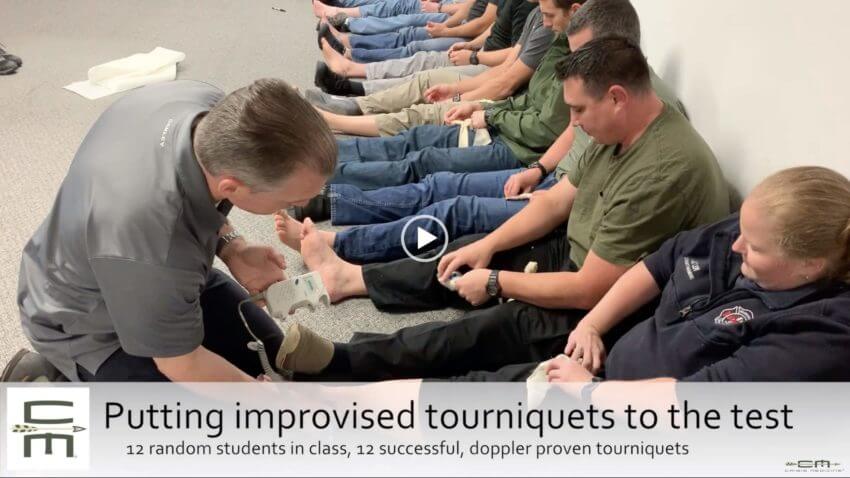
Improvised Tourniquets- 12 of 12 Successful
- Posted by Mike Shertz MD/18D
- Categories (M) Massive Hemorrhage, Improvised
Proven commercially available tourniquets are always our first choice.
🕖 Reading Time, 3 minutes
Though many say improvised tourniquets don’t work, 12 students in a recent class all successfully made them work, when using appropriate materials, verified by Doppler ultrasound.
The key to a successful improvised tourniquet is starting with a piece of fabric that is 56” long or greater, and at least 2-4” wide. In this case, we used military grade cravats that are still in date. Some cravats available on e-Bay are incredibly old and will simply crumble apart when you take them out of the packaging. Some newer cravats are not mil spec and are too small, and too thin and gauzy. You need to find the Golidlocks cravats – those that are just right.
To make an improvised tourniquet:
- Put the fabric 3-4” above the wound and not on a joint.
- Cross the fabric over itself behind the limb and bring back to the front, repeating as many times as possible, leaving yourself tails to tie
- Tie the tails into a knot
- Use a sturdy object such as a metal pen, two tongue depressors taped together, or even your trauma sheers if you have nothing else and insert this “windlass” under your knot
- Begin twisting the windlass until all bleeding stops
- You will need to secure the windlass in place, preferably by tying it in place with a second cravat.
You can also use the casualty’s own clothing to create a tourniquet, which we demonstrate in another video and blog post.
Proven commercially available tourniquets are always our first choice. Though many say improvised tourniquets don’t work, 12 students in a recent class all successfully made them work, when using appropriate materials, verified by Doppler ultrasound. For more on making a proper improvised tourniquet, see our article on Improvised Tourniquets.
The techniques posted here have some evidence and proof of concept to support their use in an emergency when better materials simply aren’t available.
Dr. Mike Shertz is the Owner and Lead Instructor at Crisis Medicine. Dr. Shertz spent over 30 years gaining the experience and insight to create and provide his comprehensive, science-informed, training to better prepare everyday citizens, law enforcement, EMS, and the military to manage casualties and wounded in high-risk environments. Using a combination of current and historical events, Dr. Shertz’s lectures include relevant, illustrative photos, as well as hands-on demonstrations to demystify the how, why, when to use each emergency medical procedure you need to become a Force Multiplier for Good.



